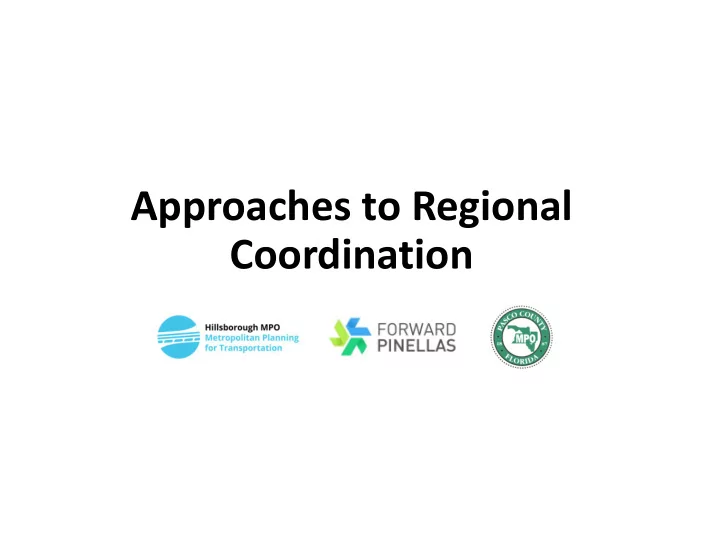

Approaches to Regional Coordination
A quick recap: TMA structure options discussion • Meeting chair to rotate with meeting location • No decision on a voting structure • Many steps to formalize the TMA Leadership Group o Clarify role with respect to the MPO Chairs’ Coordinating Committee (CCC) o Clarify TMA public engagement process o Clarify TMA decision‐making process in relation to each MPO’s decision‐making o Draft TMA bylaws o Update each MPOs’ bylaws to recognize TMA o Expand and confirm non‐voting advisors, incl. adjacent MPOs o More
A quick recap: ideas from the Best Practices Study
Looking for the pink unicorn … What is mandatory? What assets do we have for regional coordination? • Both the CCC and the TMALG are responses to requests from Tallahassee to consider merging the MPOs • The CCC was not explicitly discussed in the recent Best Practices Study What are we good at? What can we improve?
What is mandatory? • Where part of an urbanized area served by one MPO extends into an adjacent MPA [MPO planning area], the MPOs shall, at a minimum, establish written agreements that clearly identify areas of coordination and the division of transportation planning responsibilities among and between the MPOs. (CFR 450.312)
Assets: what has the CCC done well? • Track record of funded projects based on CCC priorities • Track record of jointly‐produced plans, adhering to federal reg’s • Formal interlocal agreement and operational procedures • Voting structure (one MPO, one vote) • Iterative approval process with member MPOs o CCC ability to prepare and approve a regional plan did not detract from each MPO’s ability to prepare and adopt the official plan for its area • Established public participation process ‐‐ public notice, etc. • Process for sharing financial resources, to produce plans
Assets: what has the TMA done well? • Stronger relationships between members of different boards • Deeper and broader understanding of perspectives from around the region • Building energy to move towards solutions
What can we improve? • Duplication of regional groups; confusion of roles; too many meetings • Communicate a compelling, feasible, multimodal vision for the region • Ultimately ‐ craft agreements between the counties to implement the vision • Rethink the CCC’s never‐used dispute resolution process? • More ideas?
Streamlining the regional process • Use CCC structure as a base Note: CCC staff support (a limited amount) is currently provided by contract with TBARTA: does that still make sense? With 2017 change in TBARTA’s geographic area and modal scope, should MPOs reestablish responsibility for regional multimodal plan? • Schedule time for broader discussions involving multiple board members from each MPO o Annually reconvene the TMA o Arrange some joint board meetings, among at least two MPO boards, on an as‐needed basis • Begin CCC quarterly meetings in 2020 o Continue TMA meetings this year: focus on Tri‐County Long Range Plan o Next year: expand Regional Plan to the larger CCC area • Aligns with Plan timing for MPOs in FDOT District 1 o Propose new process to CCC at summer meeting
Recommend
More recommend